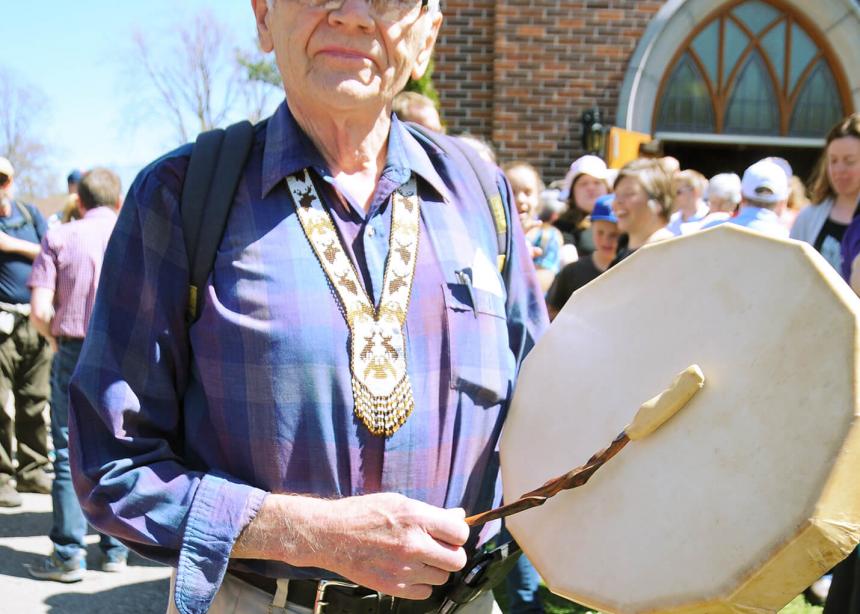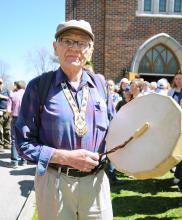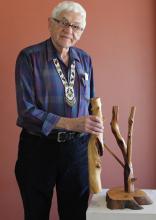Henry Neufeld is joining more than 50 other walkers in the Pilgrimage for Indigenous Rights. From April 23 to May 14, participants will cover the 600-kilometre stretch between Kitchener and Ottawa, Ont. in support of the adoption and implementation of the United Nations Declaration on the Rights of Indigenous Peoples (UNDRIP).
The walk will be a challenge, but perhaps especially so for Neufeld. He’s 87 years old and he is taking along his drum.
“I can’t go without my drum,” he says. Neufeld’s passion for drumming and singing Christian faith songs in English and Ojibway is deeply rooted in his commitment to God and to indigenous peoples. As Mennonite Church Canada workers, he and his late wife Elna lived in indigenous communities for almost 20 years, developing friendships that continue today.
In “The Drum Speaks,” a video sharing the story of Neufeld’s journey to the drum, he says, “For many years, the drum has been condemned. It has not been acceptable. In fact, the government has acted very much against the use of the drum and the people using it.”
That position was also assumed by the church, yet the drum is intrinsic to indigenous spirituality and ceremony. “It’s like a heartbeat,” Neufeld explains, “the first sound we hear in our mother’s womb.” It’s an instrument of healing and celebration.
Just as Peter was prompted several times by God to eat previously forbidden food in Acts 10:11-18, Neufeld says he was prodded several times to accept the role of a drummer. Indigenous elders invited him to sing and drum using their instruments. Eventually, an elder gifted him with her drum, and yet another elder blessed that drum for Neufeld as an instrument to honour and glorify God. When that first drum wore out, Neufeld mounted it on his wall and had another drum made.
Neufeld knows he may be criticized for using a drum. “But I am ready to take that. If I had said ‘no’ to the drum, I would have missed many blessings of building a bridge between the different cultures.” The drumming and traditional songs of Christian faith seem to resonate with indigenous peoples and settlers alike.
Neufeld considers himself a settler. He arrived in Canada as a three-month-old infant in the arms of his parents, who, like many Mennonites, left Ukraine to make a new home in a safer land. But settlers, he says, are part of the problem. “In the late 1800s a treaty was signed and an agreement made between the indigenous and the settlers of all the things that would happen, but they have not.”
While we often refer to indigenous people as “treaty people,” it is clear that we are treaty people too. “A treaty cannot be signed by one person only,” Neufeld points out.
Neufeld isn’t taking the commitment to join the pilgrimage lightly, and neither are his family members, who support his decision. A van will accompany the walkers and provide respite as necessary, but Neufeld may surprise a few people with his level of endurance. He began preparing in February with a 5-6 km jaunt every morning, adding an evening walk of the same distance in April. He’s strong and energetic, with a firm handshake that belies any sense of age-related frailty.
Ever open to symbolism, Neufeld is also bringing along a sculpture of unity created by nature—two saplings that grew together, entwined, a diamond willow and a poplar. Branches of the diamond willow represent the indigenous peoples reaching out to embrace the poplar, the settlers. He placed both saplings on an oak base representing Turtle Island, or North America. The two nest neatly together, yet slip easily apart. “One will never be the other,” Neufeld says, “but we need to recognize and intermingle and live together.”
The sculpture represents Neufeld’s vision for the pilgrimage. “With this walk, I hope to bring some awareness about the Declaration and what it means to be Treaty people together,” he says.
Learn more about the Pilgrimage for Indigenous Rights at pfir.ca. The site includes a map of the route and locations where the walkers will stop.
See also:
Mennonites plan pilgrimage for indigenous rights
A personal pilgrimage
‘Land rights apply to my church and my home’





Add new comment
Canadian Mennonite invites comments and encourages constructive discussion about our content. Actual full names (first and last) are required. Comments are moderated and may be edited. They will not appear online until approved and will be posted during business hours. Some comments may be reproduced in print.